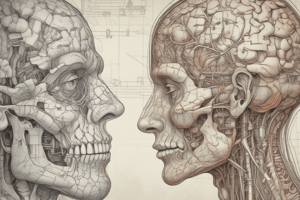Podcast
Questions and Answers
What is the term for the rapid change in the membrane potential of a neuron caused by the movement of ions?
What is the term for the rapid change in the membrane potential of a neuron caused by the movement of ions?
- Membrane depolarization
- Action potential (correct)
- Refractory period
- Resting potential
What is the typical resting membrane potential of a neuron?
What is the typical resting membrane potential of a neuron?
-70mV
_______ potentials hyperpolarize the postsynaptic cell membrane.
_______ potentials hyperpolarize the postsynaptic cell membrane.
Inhibitory postsynaptic
Match the neurotransmitters with their respective functions:
Match the neurotransmitters with their respective functions:
The neuron firing is 'all or none', meaning that the frequency of firing determines the strength of the neural signal.
The neuron firing is 'all or none', meaning that the frequency of firing determines the strength of the neural signal.
Flashcards are hidden until you start studying
Study Notes
Structure and Action of Neurons
- Identify key structural features of a neuron:
- Cell body
- Dendrites
- Axon
- Summarize the changes in resting membrane potential that lead to the initiation and propagation of an action potential:
- At rest, the membrane potential is polarized at -70mV
- When positive (Na+) ions flow into the cell, the membrane potential depolarizes, moving closer to 0 mV
- If the membrane potential reaches -50 mV, an action potential will be triggered
- Describe the "all-or-none" characteristic of an action potential and the Rate Law of action potentials:
- The neuron firing is "all or none," meaning the frequency of firing determines the strength of the neural signal
- Strong stimulus leads to faster threshold for activation, resulting in more frequent action potentials
Propagation of Action Potentials
- Ions flow in and out of the neuron membrane in the gaps between the myelin, causing the action potential to move faster
Synapse and Neurotransmission
- Describe the synapse, the mechanism of neurotransmitter release, and the activation of postsynaptic receptors:
- Synapses enable communication between neurons
- The structure of a synapse includes the terminal button, synaptic cleft, pre- and post-synaptic membranes, synaptic vesicles, and microtubules
- Neurotransmitters are synthesized within the brain/neurons and are often called "chemical messengers"
- Explain how drugs influence synaptic transmission and neuron function:
- Drugs can mimic or block the action of neurotransmitters
- Agonists activate the receptor, while antagonists block it
Neural Excitation and Inhibition
- Describe excitatory and inhibitory postsynaptic potentials (EPSPs and IPSPs):
- EPSPs depolarize the postsynaptic cell membrane, increasing the likelihood of an action potential
- IPSPs hyperpolarize the postsynaptic cell membrane, decreasing the likelihood of an action potential
- Explain how EPSPs and IPSPs are integrated:
- The combined effect of EPSPs and IPSPs is called neural integration
- Each neuron integrates the signals from incoming neurons, and the sum of the excitatory inputs must be sufficiently greater than the inhibitory inputs to cause the membrane potential to pass the threshold of activation
Neurotransmitters and Receptors
- Describe the action of neurotransmitters at receptors:
- Neurotransmitters bind to specific receptors, triggering a response
- Receptors are very selective, and each receptor can generally only be activated by one neurotransmitter
- Explain how drugs work at receptors:
- Drugs can act as agonists, activating the receptor like the natural compound, or as antagonists, blocking the receptor and preventing the natural compound from activating it
Studying That Suits You
Use AI to generate personalized quizzes and flashcards to suit your learning preferences.




